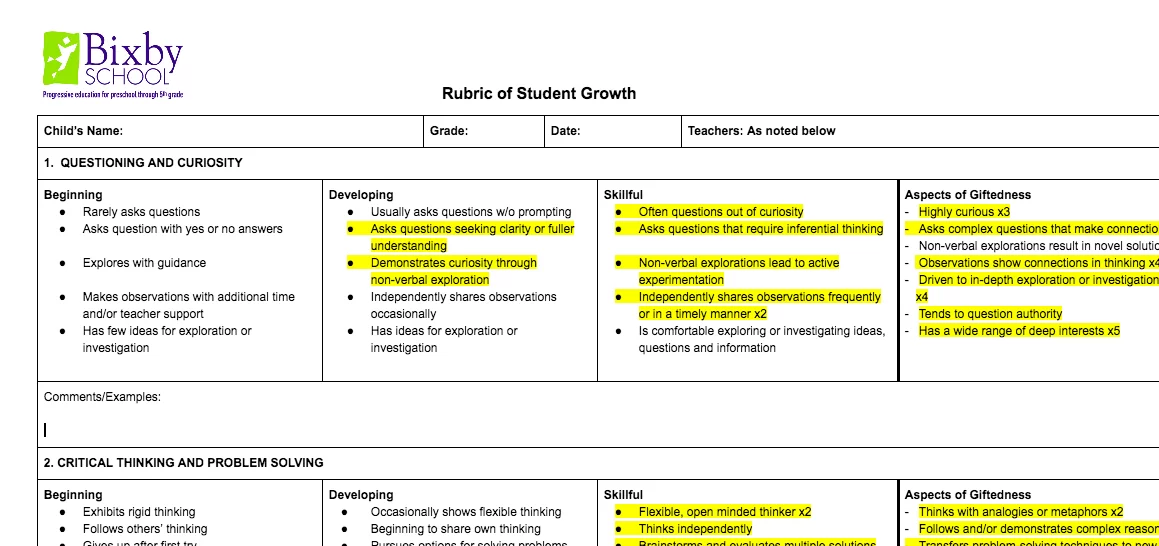I so appreciate that Anna talked about the rubrics for student growth last week, and how she spoke about learning more about the practice of teaching through filling them out. That has certainly been my experience over the last ten years or so as well.
But I have also had the good fortune of getting to help present the compiled rubrics to parents over those years, with both our founder Pat, and with our current Academic Director, Elizabeth, and almost without exception, the rubrics have led to profound conversations. One parent after another has marveled at the depth of the document, and shared variations on these themes, ‘I’m amazed at how well the teachers know my child’ or ‘This sounds like me when I was in elementary school.’ One parent, after their first dose of conferencing at a much larger school, which he likened to “speed dating,” remarked after a 75 minute conference, ‘Now, this is the way for me to get to know my child better, a real glimpse into who he is other settings.’ (And when he heard that his son was quite the storyteller, he got a smile, and had one of those ‘the apple doesn’t fall far from the tree’ moments.)
And that brings us to another powerful aspect of the rubrics—that in sharing them, we, the presenters, also get to know any given student better because we inevitably get to know their parents better—these are truly conversations of the heart and mind, for what could be closer to the heart or more on a parent’s mind than their child most of the time?
Both Pat and Elizabeth are big picture thinkers, and when they lay the rubric out as a whole (each in their own way), a story unfolds about that student. It’s hard to say how many times I’ve heard the phrase, “Look here in these first four sections, what I like to call the thinking sections (Questioning/Curiosity, Critical Thinking, Precision in Thinking, Metacognition/Reflection), see how many descriptors have been highlighted in the ‘developing’ and ‘skillful’ categories’…and look here, the descriptor, “regularly sees patterns and makes connections” has been highlighted by four different teachers—your child is deeply engaged in a variety of subject areas!
Sometimes, as we move into the middle, slightly more report card like sections (Conceptual Learning, Creativity/Artistic Expression/Movement, and Academic Skills Acquisition), we see the highlights shift over more towards ‘developing,’ with perhaps a few marks in ‘beginning’ too. This can be a hard realization for a parent, or more accurately, a hard reality to see so concretely, because they often know where their child’s challenges are (e.g.,’Yes, she is so confident when it comes to brainstorming ideas and sharing information in discussions, but the written work is tedious, even arduous for her.’). Sometimes this is another version of the apple not falling far, and our conference turns to questions (‘How did you handle that challenge in school and beyond?’…) and suggestions (‘Let your child hear your thoughts out loud as you problem solve related situations, this can both normalize the dealings with frustrations and guide them into potential strategies’…). Even during these difficult moments, when we look closely at the rubric, especially if this is that student’s second or third year here, we can see where hard won progress has been made, and all take stock in the gradual, often still fragile growth taking place. One parent recently shared a phrase at this point in the conference that went right to our hearts, “My child just seems to need a long runway.” That metaphor spoke volumes to us all, and I hope to remember it for the rest of my career!
And then we reach the ‘being’ section, who that child is in community, both within the classroom and the school as a whole (Attention Span andFocus, Risk Taking, Work Ethic and Dependability, Care for Others/Ownership of Behavior). This is where the big picture tends to crystalize—‘Look here, their attention and focus are solidly in developing, but the highlights in work ethic and dependability are mostly in ‘skillful.’ If we look back at the strong marks in precision in thinking and put these all together, we see a student that highly values accuracy (perhaps even to the point of perfectionism), and one that is also working very hard. They tend to put considerable pressure on themselves, so that part of our job becomes helping them chip away at the aspects of perfectionism that add so much pressure and may restrict their risk taking. And then we all look at ways together, both home and school, for how to support their child in their attention to detail and incredible determination, and how to skillfully apply those qualities (a lifelong practice that one parent or another, as well as a teacher or two, know all too well)!
Someday I’d like to write a whole blog about that last section of the rubric, but for now, I hope this has given you even a tiny taste of the depth of connection that can happen as we sit down to converse over these living documents.
Thank you for this opportunity to share.



